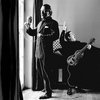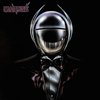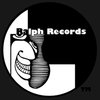






Bow Bow, Deur Bow Bow. "Yello is a band to be taken seriously, because they understand how to not take things seriously." Ruben Sindo Acosta gets us hip to the band, Yello, beyond their well-known single "Oh Yeah".
My school bus driver, Mayra was my first resident DJ. I rode Mayra’s bus to and from school from 6th grade until my senior year of high school. The converted shuttle bus painted yellow and black with “Mayra School Bus” on the side usually blared the iconic Miami Dance Music station “Power 96” loud enough to drown out the rowdy chatter of the kids on board. Power 96’s mid-nineties programming was an eclectic mix of Freestyle, Miami Bass, Dancehall, Hip Hop, Techno, House and Rave. It was also how I first heard the band Yello. The 12” single mix of Yello’s “Bostitch”, already a deep-cut classic among DJs at this point, was on rotation alongside freestyle essentials like Nice & Wild’s “Diamond Girl” and Planet Soul’s techno gem “Set U Free”.
The band Yello is mostly known within the cultural context of their 1985 novelty hit “Oh Yeah”. First featured in the iconic 1980’s film Ferris Bueller’s Day Off , it was subsequently used in countless other films, commercials, TV shows and video games over the last 35 years. The first time I actually paid attention to the song was after watching an episode of It’s Always Sunny in Philadelphia where it was referred to as “Day Bow Bow”. I was familiar with Yello’s first two albums, Solid Pleasure and Claro Que Si, because they were released on Ralph Records. Given that Ralph was the label run by San Francisco avant-garde legends, The Residents, everything they released had more clout to me. I foolishly assumed that anything after those two albums was not worth my time. Especially not “Day Bow Bow”.
On a cross-country road trip I picked up a cassette copy of Yello’s “Stella”, featuring “Oh Yeah” at a thrift store in Rawlins, Wyoming on my way back home to Brooklyn. It wasn’t until I was sitting in bumper to bumper traffic on a steamy Manhattan street with the windows down that it dawned on me “This song is actually amazing”. The cassette tape’s compressed slap, the echo off the tall buildings, the beat, the bassline, the filthy vocal. The song is not merely wacky or off kilter, it is both effortless and masterful. Something about it was very human. I cranked up the volume and let “Oh Yeah” ring out loud as we unironically danced, confusing the cars and pedestrians around us. It was fun and there is something fearless in fun.
Musically, Yello’s 14 studio albums range from Disco to New Wave to Jazz, Rock, Techno, Musique Concrete and beyond. Conceptually, Yello asks the same question that Frank Zappa asked, “Does humor belong in music?”. Zappa would often pose this question with a contemptuous bite. With Yello, the joke is never on anyone. A theme echoed in Yello’s interviews is how their goal is to “become a child. Not to stay a child, but to now as an adult become that innocence and wonder.” Though the world of Yello is often facetious and sarcastic, they are entirely “uncynical”, and were incredibly influential in the burgeoning 80s electronic dance scene as well as the early 00s explosion of electronic dance music. LCD Soundsystem name checks them in “Losing My Edge”. Yello, a long with artists like Mandre and Giorgio Moroder, is one of the many musical masks worn by French electronic music duo Daft Punk.
The music of Yello is produced by Boris Blank. Born in Bern, Switzerland in 1952, Blank was always fascinated with sounds rather than instruments toying the synthesizers at his local music shop for hours on end. He was the kid all the employees would roll their eyes at as he walked in. At 13, he began recording ambient and found sound tapes with a Revox A77 reel to reel tape machine. It started in his family’s kitchen; Blank would record pots and pans at various tape speeds, discovering wild echoes and feedback. He would then cut pieces to matching lengths and splice them together, creating a rhythm within the chaos, like a DIY sequencer. Unable to read sheet music and never considering himself a musician, Boris would pull strings off his acoustic guitar, stuff a microphone in the body and play it like a bongo.
In 1977, Blank’s hash dealer introduced him to Carlos Peron, a fellow non-musician sound nerd. With a Farfisa organ and a 4 channel mixing desk, along with Peron’s noisy synthesizer, the two began to record experimental electronic music together. Peron was all about free jazz and Blank loved King Crimson, Throbbing Gristle and Herbie Hancock. They dismissed the punk movement as a rehash of what The Stooges had already done. On a trip to San Francisco to see their American heroes The Residents and Tuxedomoon, Blank and Peron gave out demo tapes to bands hoping to release something on Ralph Records. To their surprise, upon arriving back to Switzerland, Ralph Records replied, interested to work with their (at this point) nameless band. Then, the owner of a local record store introduced the two to Dieter Meier and the chemistry amongst the three was immediate. As they played their in-progress tracks for Meier, he began to spontaneously sing. Meier also suggested the band name, more for the sound of it than any meaning, “It should sound like a children’s toy. Like Lego. Yello.”

Dieter Meier is many, many things. His father rose from poverty to become a rich banker, and Dieter was born a millionaire in Zurich, Switzerland in 1945. He used law school at the University of Zurich as a front while becoming a professional gambler for 3 years. As an admittedly clueless kid, Meier became addicted to sitting at a poker table and simply surviving - that would be the only thought, not caring about who he was, what he was doing with his life. It was a total escape from the real world. His gambling addiction waned via a new craft; experimental 8mm films and conceptual art. My favorite of Meier’s pieces is Lost Sculptures (1976), a collection of small abstract sculptures designed to be photographed once, and then destroyed. Meier had art exhibitions across Europe before dropping out of the art race in the late 1970s. When he met Boris Blank, Meier was fronting a local punk band, as well as scoring his silent films live.
The only music I played in the car after my Manhattan traffic epiphany came from a CD copy of Stella, Yello’s fourth album. I would play it for any and everyone I could. Stella was the first album made without founding member Carlos Peron, who left the band to pursue a solo career. Recorded between 1983 and 1984, Blank added 2 new synthesizers to the band’s original core of synths, drum machines, vocoder and guitar used to make the previous albums. Meier felt that as the band grew in skill, they grew into perfectionists. “Perfection is just a way to escape that you have nothing to say… with Stella we were being dragged down by perfection”. The result was a smooth and organically odd production, the kind of music you’d hear at a Sci-Fi supervillain’s party. The sounds feel less like layers and more like a busy shelf, where each small compartment has its own space, and everything on the shelf dances in a different way to the same beat. Blank finished the mixes at his home studio in Zurich and the album was released in early 1985. Thanks to the surprise success of “Oh Yeah”, Stella was the first album made by a Swiss artist to top the Swiss charts.
“Oh Yeah” opens on a bed of hyper shakers - woody electric bongos and toms wrap themselves around a slapping electro dance beat accented by a synth bass that sounds like a guttural death metal singer…then the lead vocal. Blank asked Meier to picture being a “fat little monster on a beautiful beach at sunset” resulting in a twisted pitched down swaggering contra-baritone belting “The Moon, beautiful. The Sun, even more beautiful. Oh Yeah.” and the scatting loop of “Chk- Chkchkaa” and the Gregorian chants of “Bow Bow, Deur Bow Bow” The song then bounces through various breaks that feel as though J Dilla produced a Post-Punk Techno song; dropping from pulsing sequencer bass to drilling industrial noise screams. Suddenly, the demented voices are your guide through the twists and turns of this combination of a roller coaster and a bounce house. Indeed, the “Yello Circus has joy and entertainment in the center ring”.
“Oh Yeah” is far from Yello’s best song, but is a fantastic example of why they’re worth a deep listen. Yello is a band to be taken seriously, because they understand how to not take things seriously. Their playful aesthetic is the unifying factor in a vast catalog that features a wide range of genres and sounds. Since their first album, Yello has self produced all their music, artwork and music videos. Boris Blank’s’ active, non-musician style results in a rich array of artistically valuable music for adventurous listeners. I would play Yello while working at a record shop and toward the middle of the A side inevitably be asked “Is this still Yello?” by friends who were both confused and entertained. Most Yello albums sound like a contemporary playlist made by your most eccentric friend.
Frank Zappa used to say “writing about music is like dancing about architecture” and I agree. Thanks to my love for the music created by Boris Blank and Dieter Meier, I can flail with reckless abandon about this incredibly inspiring circus tent called “Yello”.







